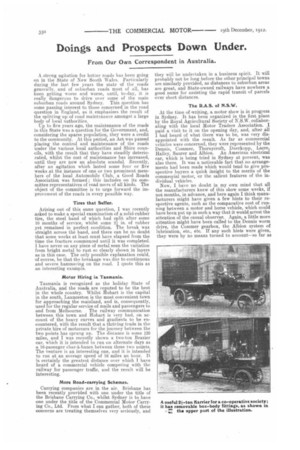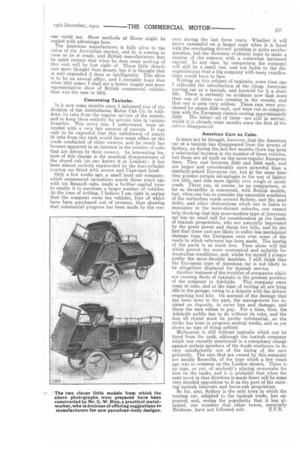Doings and Prospects Down Under.
Page 14

Page 15

If you've noticed an error in this article please click here to report it so we can fix it.
From Our Own Correspondent in Australia.
A strong agitation for better roads has been going on in the State of New South Wales. Particularly during the las+, few years the state of the roads generally. an of suburban roads most of all, has been getting worse and worse, until, to-day, it is really dangerous to drive over some of the main suburban roads around Sydney. This question has some passing interest to those concerned, in the road question in England, as it emphasizes the result of the splitting up of Toad maintenance amongst a large body of local authorities.
Up to five years ago, the maintenance of the roads in this State was a question for the Government, and, considering the sparse population, they were a credit to the community. At this period, an Act was passed placing the control and maintenance of the roads under the various local authorities and Shire councils, with the result that they have steadily deteriorated, whilst the cost of maintenance has increased, :until they are now an absolute scandal. Recently, after an agitation which lasted some four or five weeks at the instance of one or two prominent members of the local Automobile Club, a Good Roads Association was formed ; this includes on its committee representatives of road users of all kinds. The object of the committee is to urge forward the improvement of the roads in every possible way,
Tires that Suffer.
Arising out of this same question, I was recently .asked to make a special examination of a solid-rubber tire, the steel band of which had split after some 10 months of service, whilst some 21 in. of rubber yet remained in perfect condition. The break was straight across the band, and there can be no doubt that some weeks at least must have elapsed from the time the fracture commenced until it was completed. I have never on any piece of metal seen the variation from bright metal to rust so clearly shown in layers as in this case. The only possible explanation could, of course, be that the breakage was due to continuous and severe hammering on the road. I quote this as an interesting example.
Motor Hiring in Tasmania.
Tasmania is recognized as the holiday State of Australia., and the roads are reputed to be the best in the whole country. Whilst Hobart is the capital in the south, Launceston is the most convenient town for approaching the mainland, and is, consequently, used for the regular service of mails and passengers to and from Melbourne. The railway communication between this town arid Hobart is very bad, on account of the heavy curves and gradients to be encountered, with the result that a thriving trade in the private hire of motorcars for the journey between the two points has sprung urs The distance is some 120 miles, and I was recently shown a two-ton Brasier car, which it is intended to run on alternate days as a 16-pasenger char-k-bancs between these two points. he venture is an interesting one, and it is intended to run at an average speed of 16 miles an hour. It is certainly the greatest distance over which 1 have heard of a, commercial vehicle competing with the railway for passenger traffic, and the result will be interesting.
More Road-carrying Schemes.
Carrying companies are in the air. Brisbane has been recently provided with one under the title of the Brisbane Carrying Co., whilst Sydney is to have one under the title of the Commercial Motor Carrying Co., Ltd. From what I can gather, both of these concerns are treating themselves very seriously, and they will be undertaken in a business spirit. It will probably not be long before the other principal towns are similarly provided, as distances to suburban areas are great., and State-owned railways have nowhere a good name for assisting the rapid transit of parcels over short distances.
The R.A.S. of N.S.W.
At the time of 'writing, a motor show is in progress in Sydney. It has been organized in the first place by the Royal Agricultural Society of N.S.W. collaborating with the local Motor Traders Association. .I paid a visit to it on the opening day, and, after all I had heard of what there was to be, was very disappointed with the result. As far as commercial vehicles were concerned, they were represented by the Dennis, Conuner, Thornycroft, Duerkopp, Lacre Halley, Bawer and Albion. An American electrical car, which is being tried in Sydney at present, was also there. It was a noticeable fact that 110 arrangements had been made which would tend to give prospective buyers a quick insight to the merits of the commercial motor, or the salient features of the individual vehicles. Now, I have no doubt in my own mind that all the manufacturers knew of this show some weeks, if not months, in advance, and here again I think manufacturers might have given a few hints to their respective agents, such as the comparative cost of running between a motor and horse vehicle, which could have been put up in such a way that it would arrest the attention of the casual observer. Again, a little more attention might have been called to the Dennis worm drive, the Commer gearbox, the Albion system of lubrication, etc., etc. If any such hints were given, they were by no means turned to account—so -far as
one could see. Show methods at Home might be copied with advantage here.
The American manufacturer is fully alive to the value of the Australian market, and he is coming as soon as he is ready, and British manufacturers may be quite certain that when he does come nothing of this sort will be lost sight of. These little details cost more thought than money, but it is thought that is well expended if done so intelligently. This show is to be an annual affair, and I certainly hope that when 1913 comes I shall see a. better staged and more representative show of British commercial vehicles than was the case in 1912,
Concerning Taxicabs.
It is now some months since I informed you of the decision of the Australasian Motor Cab Co. to withdraw its cabs from the regular service of the streets, and to keep them entirely for private hire in various branches. This move has, I understand, been attended with a very fair amount of success. It was only to be expected that this withdrawal of nearly 50 cabs from the rank would have some effect on the trade conducted of other owners, and its result has become apparent in an increase in the number of cabs that are driven by their owners. An interesting feature of this change is the practical disappearance of the closed cab (as one knows it in London) ; it has been almost entirely superseded by the four-cylinder touring car fitted with screen and Cape-cart hood.
Only a few weeks ego, a small local cab company, which commenced operations nearly three years ago with six Renault cabs, made a further capital issue to enable it to purchase a larger number of vehicles. At the time of writing, I believe I am right in saying that the company owns ten vehicles, four of which have been purchased out of revenue, thus showing that substantial progress has been made by the con
cern during the last three years. Whether it will prove successful on a larger scale when it is faced with the everlasting drivers' problem is quite another question, but the directors evidently hope to make a success of the concern with a somewhat increased capital. In any case, by comparison the company will still be a small one, and not liable to the disorganizations that a big company with many ramifications would have to face.
Writing on this subject of taxicabs, some time ago I ridiculed the introduction of the cheap American touring car as a taxicab, and foretold for it a short life. 'There is certainly no evidence now that more than one of these cars remains in the streets, and that one is seen very seldom. These cars were purchasedfor about £300 each, and were run in competition with the European chassis costing approximately £500. The latter—,all of them --are still in service, whilst it is already some months since the first of the others disappeared.
American Cars as Cabs.
It must not be thought, however, that the American car ats a taxicab has disappeared from the streets of Sydney, as during the last few months there has been. a substantial increase in the number of these vehicles, but those are all built on the more-regular European lines. They cost between £500 and £600 each, and are larger and considerably more powerful than a similarly-priced European car, but at the same time• they possess certain advantages in the way of lighter tire bills, and ride more lightly over rough or sandy roads. There can, of course be no comparison, so far as durability is concerned, with British models, but, when one has to consider the execrable condition of the surburban roads around Sydney, and the sand drifts, .and other obstructions which one is liable to encounter in the more-distant suburbs, one cannot help thinking that this more-modern type of American ear has no small call for consideration at the hands of taxicab proprietors, who are naturally impressed by the great power and cheap tire bills, and by the fact that these cars are likely to suffer less mechanical damage than the European ones over some of the roads to which reference has been made. The inertia of the parts is so much less. Time alone will tell which proves the more economical and suitable for Australian conditions, and, whilst for myself I always prefer the more-durable machine, I still think that the European type of American car is not likely to be altogether displaced for taxicab service.
Another instance of the troubles of companies which are running fleets of taxicabs is the present position of the company in Adelaide. This company owns some 40. cabs, and at the time of writing all are lying idle in the garage, owing to a dispute with the drivers respecting tool kits. On account of the damage that has been done in the past, the management has in sisted on deposits, to cover loss and damage, and these the men refuse to pay. For a time, thus, the Adelaide public has to do without it cabs, and the loss all round must be pretty substantial, a.s the strike has been in progress several weeks, and as yet shows no sign of being settled. Melbourne is still without taxicabs which can be hired from the rank, although the taxicab company which was recently mentioned in a conspiracy charge against certain members of the trade continues to do very satisfactorily out of the hiring of the cars privately. The cars that are owned by this company are mostly Renaults, of the type which a few years ago was so common on the London streets. There is no sign, as yet, of anybody's placing motorcabs for hire on the ranks, and it is probable that when the next move in that direction is made there will be some very decided opposition to it on the part of the existing taxicab interests and horse-cab proprietors. So far, also, Sydney is the only town in which the touring car, adapted to the taxicab trade, has ap peared, and, seeing the popularity that it has attained, one wonders that other towns, especially Brisbane, have not followed suit. E.F.B.




















